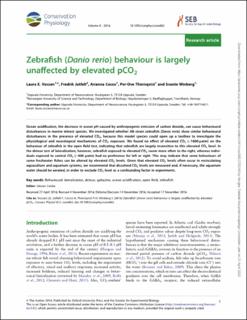| dc.contributor.author | Vossen, Laura | |
| dc.contributor.author | Jutfelt, Fredrik | |
| dc.contributor.author | Cocco, Arianna | |
| dc.contributor.author | Thörnqvist, Per-Ove | |
| dc.contributor.author | Winberg, Svante | |
| dc.date.accessioned | 2020-04-22T13:39:36Z | |
| dc.date.available | 2020-04-22T13:39:36Z | |
| dc.date.created | 2017-01-03T12:23:44Z | |
| dc.date.issued | 2016 | |
| dc.identifier.citation | Conservation Physiology. 2016, 4 (1), . | en_US |
| dc.identifier.issn | 2051-1434 | |
| dc.identifier.uri | https://hdl.handle.net/11250/2652128 | |
| dc.description.abstract | Ocean acidification, the decrease in ocean pH caused by anthropogenic emission of carbon dioxide, can cause behavioural disturbances in marine teleost species. We investigated whether AB-strain zebrafish (Danio rerio) show similar behavioural disturbances in the presence of elevated CO2, because this model species could open up a toolbox to investigate the physiological and neurological mechanisms of CO2 exposure. We found no effect of elevated CO2 (~1600 μatm) on the behaviour of zebrafish in the open field test, indicating that zebrafish are largely insensitive to this elevated CO2 level. In the detour test of lateralization, however, zebrafish exposed to elevated CO2 swam more often to the right, whereas individuals exposed to control CO2 (~400 μatm) had no preference for left or right. This may indicate that some behaviours of some freshwater fishes can be altered by elevated CO2 levels. Given that elevated CO2 levels often occur in recirculating aquaculture and aquarium systems, we recommend that dissolved CO2 levels are measured and, if necessary, the aquarium water should be aerated, in order to exclude CO2 level as a confounding factor in experiments. | en_US |
| dc.language.iso | eng | en_US |
| dc.publisher | Oxford Academic | en_US |
| dc.rights | Navngivelse 4.0 Internasjonal | * |
| dc.rights.uri | http://creativecommons.org/licenses/by/4.0/deed.no | * |
| dc.title | Zebrafish (Danio rerio) behaviour is largely unaffected by elevated pCO2 | en_US |
| dc.type | Peer reviewed | en_US |
| dc.type | Journal article | en_US |
| dc.description.version | publishedVersion | en_US |
| dc.source.pagenumber | 8 | en_US |
| dc.source.volume | 4 | en_US |
| dc.source.journal | Conservation Physiology | en_US |
| dc.source.issue | 1 | en_US |
| dc.identifier.doi | 10.1093/conphys/cow065 | |
| dc.identifier.cristin | 1419855 | |
| dc.description.localcode | © The Author 2016. Published by Oxford University Press and the Society for Experimental Biology. This is an Open Access article distributed under the terms of the Creative Commons Attribution License (http://creativecommons.org/licenses/by/4.0/), which permits unrestricted reuse, distribution, and reproduction in any medium, provided the original work is properly cited. | en_US |
| cristin.ispublished | true | |
| cristin.fulltext | original | |
| cristin.qualitycode | 1 | |

